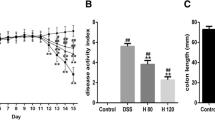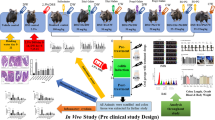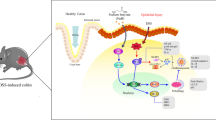Abstract
Reactive oxygen species (ROS) are increased in inflammatory bowel disease (IBD) and have been implicated as mediators of intestinal inflammation. We investigated the hypothesis that N-acetylcysteine (NAC) as a glutathione (GSH) precursor attenuates disease progression in a murine dextran sodium sulfate (DSS)-induced colitis model. A colitis model was induced by adding 5% DSS into the drinking water for 7 days. BALB/c mice were injiciatur enema with saline, 5-ASA, N-acetylcysteine, respectively, and free drinking water as control group. DSS-treated mice developed severe colitis as shown by bloody diarrhea, weight loss, and pathologic involvement. Colon lengths were significantly decreased in DSS-treated mice with decreased GSH activity too (P < 0.01). ROS in the colon, the level of interleukin 1β (IL-1β) in colonic mucosa, serum tumor necrosis factor a (TNF-α), MPO, and MDA were significantly increased in DSS-treated animals (P < 0.01), with decreased PON1 activity (P < 0.01). However, NAC significantly decreased colonic MPO activity, ROS, TNF-α and IL-1β levels and increased PON1 activity and GSH concentration. Moreover, NAC attenuated the macroscopic colonic damage and the histopathologic changes-induced by DSS while similar to 5-ASA group. These results suggest that NAC may be effective in the treatment of colitis through its up-regulating PON1 and scavenging oxygen-derived free radicals.




Similar content being viewed by others
References
Strober W, Murray PJ, Kitani A, et al. Signalling pathways and molecular interactions of NOD1 and NOD2. Nat Rev Immunol. 2006;6:9–20. doi:10.1038/nri1747.
Netea MG, Kullberg BJ, de Jong DJ, et al. NOD2 mediates anti-inflammatory signals induced by TLR2 ligands: implications for Crohn’s disease. Eur J Immunol. 2004;34:2052–2059. doi:10.1002/eji.200425229.
Mawdsley JE, Jenkins DG, Macey MG, et al. The effect of hypnosis on systemic and rectal mucosal measures of inflammation in ulcerative colitis. Am J Gastroenterol. 2008;103(6):1460–1469. doi:10.1111/j.1572-0241.2008.01845.x.
Lee HS, Han SY, Bae EA, et al. Lactic acid bacteria inhibit proinflammatory cytokine expression and bacterial glycosaminoglycan degradation activity in dextran sulfate sodium-induced colitic mice. Int Immunopharmacol. 2008;8(4):574–580. doi:10.1016/j.intimp.2008.01.009.
Rahimi R, Nikfar S, Abdollahi M. Meta-analysis technique confirms the effectiveness of anti-TNF-alpha in the management of active ulcerative colitis when administered in combination with corticosteroids. Med Sci Monit. 2007;13(7):PI13–PI18.
Rahimi R, Nikfar S, Abdollahi Mohammad. Do anti-tumor necrosis factors induce response and remission in patients with acute refractory Crohn’s disease? A systematic meta-analysis of controlled clinical trials. Biomed Pharmacother. 2007;61(1):75–80. doi:10.1016/j.biopha.2006.06.022.
Rahimi R, Nikfar S, Rezaie A, et al. A meta-analysis of broad spectrum antibiotic therapy in patients with active Crohn’s disease. Clin Ther. 2006;28:1983–1988. doi:10.1016/j.clinthera.2006.12.012.
Rahimi R, Nikfar S, Rezaie A, et al. A meta-analysis of antibiotic therapy for active ulcerative colitis. Dig Dis Sci. 2007;52(11):2920–2925. doi:10.1007/s10620-007-9760-1.
Helieh Oza TS, Theresa Chenb S, Craig McClain J, et al. Antioxidants as novel therapy in a murine model of colitis. J Nutr Biochem. 2005;16:297–304. doi:10.1016/j.jnutbio.2004.09.007.
Isozaki Y, Yoshida N, Kuroda M, et al. Effect of a novel water-soluble vitamin E derivative as a cure for TNBS-induced colitis in rats. Int J Mol Med. 2006;17(3):497–502.
Kruidenier L, Kuiper I, Lamers CB, et al. Intestinal oxidative damage in inflammatory bowel disease: semi-quantification, localization, and association with mucosal antioxidants. J Pathol. 2003;201(1):28–36. doi:10.1002/path.1409.
Mrtensson J, Jain A, Meister A. Glutathione is required for intestinal function. Proc Natl Acad Sci USA. 1990;87:1715–1719. doi:10.1073/pnas.87.5.1715.
Soltan-Sharifi MS, Mojtahedzadeh M, Najafi A, et al. Improvement by N-acetylcysteine of acute respiratory distress syndrome through increasing intracellular glutathione, and extracellular thiol molecules and anti-oxidant power: evidence for underlying toxicological mechanisms. Hum Exp Toxicol. 2007;26(9):697–703. doi:10.1177/0960327107083452.
Ebrahimi F, Esmaily H, Baeeri M, et al. Molecular evidences on the benefit of N-acetylcysteine in experimental colitis. Cent Eur J Biol 2008;3(2):135–142. doi:10.2478/s11535-008-0005-x.
Durrington PN, Mackness B, Mackness MI. Paraoxonase and atherosclerosis. Arterioscler Thromb Vasc Biol. 2001;21:473–480.
Baskol G, Baskol M, Yurci A, et al. Serum paraoxonase 1 activity and malondialdehyde levels in patients with ulcerative colitis. Cell Biochem Funct. 2006;24(3):283–286. doi:10.1002/cbf.1224.
Rothem L, Hartman C, Dahan A, et al. Paraoxonases are associated with intestinal inflammatory diseases and intracellularly localized to the endoplasmic reticulum. Free Radic Biol Med. 2007;43:730–739. doi:10.1016/j.freeradbiomed.2007.05.003.
Kanauchi O, Nakamura T, Agata K, et al. Effects of germinated barley food stuff on dextran sulfate sodium-induced colitis in rats. J Gastroenterol. 1998;33:179–188. doi:10.1007/s005350050067.
Sanders LM, Henderson CE, Hong MY, et al. Pro-oxidant environment of the colon compared to the small intestine may contribute to greater cancer susceptibility. Cancer Lett. 2004;208:155–161. doi:10.1016/j.canlet.2003.12.007.
Suzuki K, Sugimura K, Hasegawa K, et al. Activated platelets in ulcerative colitis enhance the production of reactive oxygen species by polymorphonuclear leukocytes. Scand J Gastroenterol. 2001;36:1301–1306. doi:10.1080/003655201317097164.
Qualls JE, Kaplan AM, van Rooijen N, et al. Suppression of experimental colitis by intestinal mononuclear phagocytes. J Leukoc Biol. 2006;80(4):802–815. doi:10.1189/jlb.1205734.
Rezaie A, Parker RD, Abdollahi M. Oxidative stress and pathogenesis of inflammatory bowel disease: an epiphenomenon or the cause? Dig Dis Sci. 2007;52(9):2015–2021. doi:10.1007/s10620-006-9622-2.
Banan A, Choudhary S, Zhang Y, et al. Oxidant-induced intestinal barrier disruption and its prevention by growth factors in a human colonic cell line: role of the microtubule cytoskeleton. Free Radic Biol Med. 2000;28(5):727–738. doi:10.1016/S0891-5849(00)00160-X.
Kruidenier L, Kuiper I, Van Duijn W, et al. Imbalanced secondary mucosal antioxidant response in inflammatory bowel disease. J Pathol. 2003;201(1):17–27. doi:10.1002/path.1408.
Aw TY. Intestinal glutathione: determinant of mucosal peroxide transport, metabolism, and oxidative susceptibility. Toxicol Appl Pharmacol. 2005;204(3):320–328. doi:10.1016/j.taap.2004.11.016.
Aviram M, Billecke S, Sorenson R, et al. Paraoxonase active site required for protection against LDL oxidation involves its free sulfhydryl group and is different than that required for its arylesterase/paraoxonase activities: selective action of human paraoxonase allozymes Q and R. Arterioscler Thromb Vasc Biol. 1998;18:1617–1624.
Aviram M, Rosenblat M, Billecke S, et al. Human serum paraoxonase (PON 1) is inactivated by oxidized low density lipoprotein and preserved by antioxidants. Free Radic Biol Med. 1999;26:892–904.
Liu Y-H, Liu L-Y, Wu J-X, et al. Comparison of Captopril and Enalapril to study the role of the sulfhydryl-group in improvement of endothelial dysfunction with ACE inhibitors in high dieted methionine mice. J Cardiovasc Pharmacol. 2006;47(1):82–88.
Nosal’ova V, Cerna S, Bauer V. Effect of N-acetylcysteine on colitis induced by acetic acid in rats. Gen.Pharmaco. 2000;35(2):77–81.
Scarpulla RC. Nuclear activators and coactivators in mammalian mitochondrial biogenesis. Biochim Biophys Acta. 2002;1576:1–14.
Barnes PJ, Karin M. Nuclear factor-kappaB: a pivotal transcription factor in chronic inflammatory diseases. N Engl J Med. 1997;336:1066–1071.
Kumon Y, Nakauchi Y, Suehiro T, et al. Proinflammatory cytokines but not acute phase serum amyloid A or C-reactive protein, downregulate paraoxonase 1 (PON1) expression by Hep G2. Amyloid. 2002;9:160–164.
Chromik AM, Müller AM, Albrecht M, et al. Oral administration of taurolidine ameliorates chronic DSS colitis in mice. J Invest Surg. 2007;20(5):273–282.
Paganelli M, Albanese C, Borrelli O, et al. Inflammation is the main determinant of low bone mineral density in pediatric inflammatory bowel disease. Inflamm Bowel Dis. 2007;13(4):416–423.
Author information
Authors and Affiliations
Corresponding author
Rights and permissions
About this article
Cite this article
You, Y., Fu, JJ., Meng, J. et al. Effect of N-acetylcysteine on the Murine Model of Colitis Induced by Dextran Sodium Sulfate Through Up-Regulating PON1 Activity. Dig Dis Sci 54, 1643–1650 (2009). https://doi.org/10.1007/s10620-008-0563-9
Received:
Accepted:
Published:
Issue Date:
DOI: https://doi.org/10.1007/s10620-008-0563-9




